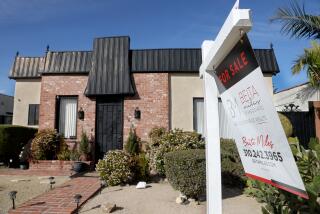Your Mortgage : Trust Deeds, Mortgages Different : Loans: Third party involved in trust deeds until paid off, while mortgage is between the lender and borrower.
Consumers and even lenders tend to use the terms mortgage and trust deed interchangeably. Itâs no wonder: Both instruments essentially create a lien on a home, and both allow the lender to foreclose if the borrower doesnât pay the money back.
Yet, knowing the difference between a mortgage and a trust deed is helpful, especially if youâll be shopping for a loan during the spring home-buying season.
A mortgage is the easiest of the two instruments to understand. Itâs a legal contract in which the borrower--known as the mortgagor--pledges the house as security against a loan to be paid back to the lender, known as the mortgagee.
Title to the property is held by the borrower, but the lender is given a lien on the property as security for the loan.
Although a mortgage was once the primary tool used to secure real estate loans, most lenders in California and other states now prefer to use deeds of trust.
âA trust deed is much like a mortgage, except it involves three parties,â said Gov Hutchinson, one of the California Assn. of Realtorsâ top lawyers.
âFirst, thereâs the borrower, whoâs called the âtrustor.â Then thereâs the lender, whoâs called the âbeneficiary.â
âAnd finally, thereâs a third party involved, called the âtrustee.â â
The trustee holds equitable title to the property until the borrower pays off the loan. When that happens, title is transferred--âreconveyedâ--to the borrower.
Many years ago, the rules for foreclosing on a borrower who had a mortgage and a borrower who had a trust deed varied greatly. But now, said Jim Sage, general counsel of Great Western Bank, âmost state governments have since changed their rules, and that has brought more uniformity to the foreclosure process.â
If a borrower defaults on the loan, the lender must usually first send him a ânotice of default.â
Depending on state law, the borrower then has a specified period of time in which to make up the missed payments. In California and many other states, this so-called âredemptionâ period lasts for three months.
Actually, California borrowers sometimes get more than three months because state law allows them to redeem their loan up to five business days prior to the foreclosure sale, Sage said.
So, if the lender decided to set a sale date thatâs six months away, the borrower would have more than three months to redeem.
If the redemption period passes and the borrower still hasnât brought the loan up to date, the lender can âaccelerateâ the loan.
âThis means that the entire loan is now due and payable, and the only way that the borrower can save the property is to pay the loan off completely and reimburse the lender for the expenses it incurred over the course of the foreclosure proceedings,â Sage said.
If worse comes to worst, the lender will sell the property at public auction. If the sale proceeds exceed the amount of the loan, any excess will be returned to the borrower--assuming that there are no âjuniorâ loans or liens on the property, such as a second mortgage or tax lien.
Selling a house at public auction can be risky for lenders because--in California and most other states--a financial institution that orders a sale must usually give up the right to sue the borrower in court. If the sale doesnât generate enough cash to pay off the loan, the lender can take a big loss.
Itâs important to remember, though, that only the âseniorâ lender on the property--the one who holds the first mortgage--must give up the right to sue. If thereâs a second or third mortgage on the property, the lenders who made those loans can still take the borrower to court in an effort to recover their losses.
The California Assn. of Realtors recently released its 1989 Housing Finance Survey, and the 42-page report provides some interesting insights on how people finance transactions in the nationâs most-expensive housing market.
* While fixed-rate loans may be preferred by many consumers, most buyers in the state last year opted for adjustable-rate mortgages--presumably because theyâre easier to obtain. But the popularity of ARMs slipped last year: 52% of all deals were financed with the loans, compared to 58% in 1988.
* Fixed-rate loans accounted for 42% of lending activity last year, up from 40% in 1988. The rest of the loans were primarily âcompressed buy-down loansâ that start with a below-market rate thatâs raised at specified intervals.
* Although prices statewide jumped 18% last year, about 8% of buyers paid all-cash for their homes--the highest level since the realtors started keeping records in 1981. The report says all-cash purchases have risen steadily since 1983, reflecting the growing amount of equity that has been built up by repeat buyers.
* Half of all sellers last year netted more than $87,150 from their transactions; half netted less.
* Condominium and townhouse sales accounted for 23.4% of all resale activity last year, up from 14.7% in 1988. About 54% of those condos and townhouses were purchased by first-time buyers.
* Singles and ânon-traditional householdsâ--two or more unmarried individuals--accounted for 37.5% of all purchases last year, up from 31.6% in 1988. The report says high divorce rates, lower marriage rates and the rising cost of homes should keep the proportion of unmarried co-purchasers âat high levelsâ throughout the decade.
The report had at least one finding that wasnât at all surprising: Fewer than one-third of all buyers last year earned less than $50,000, and nearly one-quarter earned more than $100,000. The median income of all buyers was $60,000, up 25% from the 1988 median of $48,000.
More to Read
Inside the business of entertainment
The Wide Shot brings you news, analysis and insights on everything from streaming wars to production â and what it all means for the future.
You may occasionally receive promotional content from the Los Angeles Times.










